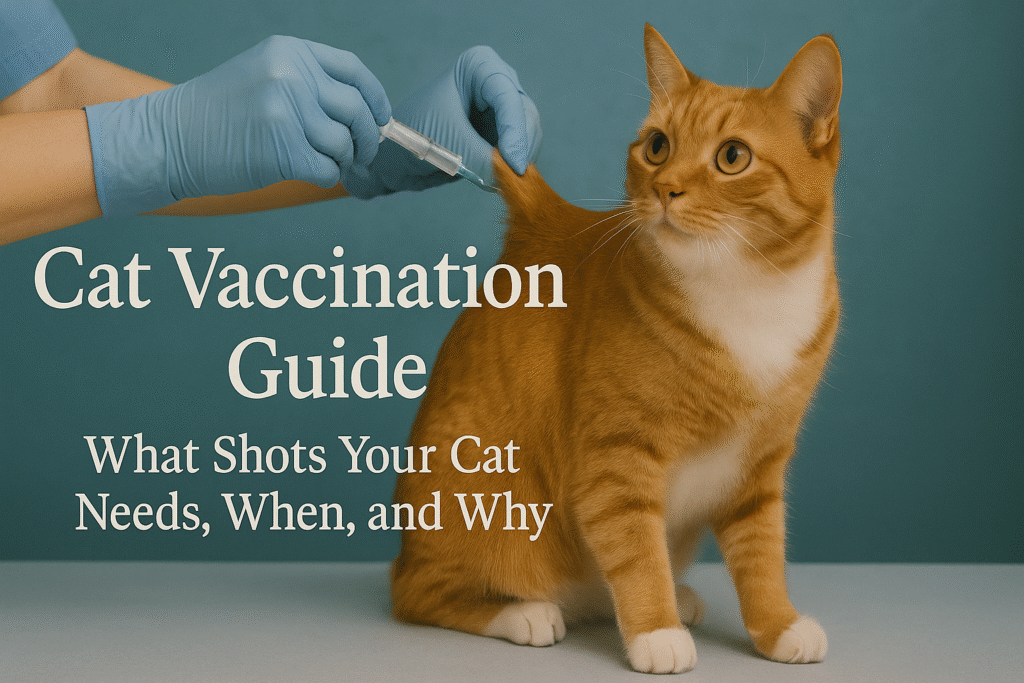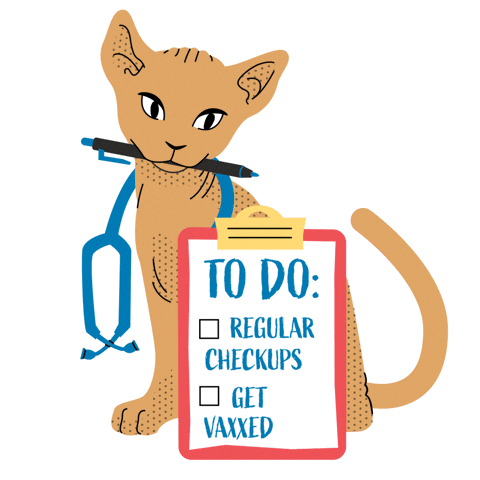
Whether you’re a first-time cat owner or a seasoned pet parent, one of the most important responsibilities is keeping your feline friend healthy and protected. Vaccinations play a critical role in preventing life-threatening diseases, and understanding what shots your cat needs, when they should receive them, and how lifestyle factors (like indoor vs. outdoor living) influence those needs can help ensure your cat lives a long, happy life.
In this comprehensive cat vaccination guide from Daily Pet Tracker, we’ll explore:
- Why cat vaccinations matter
- Core vs. non-core cat vaccines
- The ideal kitten vaccination schedule
- Adult and senior cat vaccination needs
- Indoor vs. outdoor cat vaccination differences
- Common vaccine side effects and safety
- A printable checklist for tracking your cat’s shots
Let’s dive in.
🐾 Why Cat Vaccinations Are Essential
Vaccines prepare your cat’s immune system to recognize and fight dangerous diseases. They either contain weakened or inactive versions of viruses/bacteria or genetic material that mimics the virus. Once introduced into the body, vaccines stimulate the immune system to build defenses without causing the disease.

Even indoor cats can be at risk of infection due to:
- Human contact (viruses can hitch a ride on clothing or shoes)
- Vet visits or grooming appointments
- Accidental escapes or exposure to unvaccinated pets
Vaccinating your cat protects not just them—but also other animals in your household and your community. Some feline diseases are highly contagious and difficult to treat, making prevention the best defense.
🧪 Core vs. Non-Core Cat Vaccines: What’s the Difference?
Veterinarians divide vaccines into two categories:
✅ Core Vaccines (Recommended for ALL Cats)
These protect against diseases that are widespread, often fatal, and easily transmissible.
- FVRCP Vaccine (a combo vaccine for three diseases):
- Feline Viral Rhinotracheitis – caused by feline herpesvirus, a severe upper respiratory infection
- Calicivirus – another contagious respiratory illness
- Panleukopenia – a deadly parvovirus also known as feline distemper
- Rabies – fatal to both pets and humans; required by law in many regions.
🟡 Non-Core Vaccines (Based on Risk Factors)
Given based on your cat’s lifestyle, environment, and exposure risks.
- FeLV (Feline Leukemia Virus) – recommended for kittens and outdoor cats
- Bordetella – a respiratory infection more common in shelters or multi-cat homes
- Chlamydia – part of some FVRCP combos but not always necessary
- FIV (Feline Immunodeficiency Virus) – for high-risk outdoor cats
Your vet will determine which non-core vaccines are appropriate after a lifestyle assessment.
🐱 Kitten Vaccination Schedule (Birth to 16 Weeks)
Kittens have developing immune systems and need multiple rounds of vaccines to build strong immunity.
Here’s a standard schedule:
| Age | Vaccine(s) |
|---|---|
| 6–8 weeks | FVRCP (1st dose) |
| 10–12 weeks | FVRCP (2nd dose), FeLV (if needed) |
| 14–16 weeks | FVRCP (final dose), FeLV (2nd dose), Rabies |
| 1 year | Boosters for FVRCP, Rabies, FeLV (if needed) |
📝 Important Tip: Vaccinations must be spaced 3–4 weeks apart. Don’t skip any doses!
Kittens are especially vulnerable to viruses like panleukopenia and should never go outside until fully vaccinated.
🐈 Adult Cat Vaccination Schedule
After their kitten boosters, adult cats need regular booster shots throughout life.
| Age / Timeframe | Vaccine(s) |
|---|---|
| 1 year | Rabies, FVRCP, FeLV (if outdoor or high-risk) |
| Every 1–3 years* | Rabies (based on law), FVRCP |
| Annually (for outdoor cats) | FeLV booster |
*Some vaccines, like rabies and FVRCP, now have 3-year options. Discuss this with your vet.
🧓 Senior Cat Vaccination (10+ Years)
Older cats still need vaccines, but your vet may adjust the frequency based on:
- Health status (e.g. chronic illness)
- Lifestyle (strictly indoor vs. outdoor)
- Previous vaccination history
Most senior cats continue to receive rabies and FVRCP every 3 years, unless medically exempt.
🏠 Indoor vs. Outdoor Cats: Does It Make a Difference?
Yes—and no.
✅ Indoor Cats Still Need Core Vaccines
Even if your cat lives strictly indoors, they must still get:
- FVRCP: These viruses can spread via shared airspace or surfaces
- Rabies: Required by law and crucial for protecting humans too
- FeLV (for kittens): Recommended during their first year to build immunity
Why? You could unknowingly bring in viruses on your shoes, clothes, or hands. Fleas and mosquitoes that enter your home can also carry disease.
🐾 Outdoor Cats Need Additional Protection
Outdoor cats or indoor-outdoor cats are at higher risk due to:
- Contact with stray or unvaccinated cats
- Exposure to wildlife (especially rabies carriers)
- Fights and bites, which can spread FeLV or FIV
Recommended for outdoor cats:
- Core vaccines (FVRCP, Rabies)
- FeLV – strongly advised
- FIV – optional based on risk assessment
👉 Track Your Cat’s Lifestyle Changes: If your indoor cat starts venturing outside, update their vaccine plan.
💉 Are Cat Vaccines Safe?
Yes—modern feline vaccines are extensively tested and considered very safe. Side effects are rare but can include:
- Mild fever or sleepiness for 24–48 hours
- Soreness at injection site
- Temporary loss of appetite
🩺 Call your vet immediately if you notice:
- Vomiting or diarrhea
- Swelling around the face or injection site
- Difficulty breathing
- Collapse or extreme lethargy
These may indicate an allergic reaction (anaphylaxis), which is treatable if caught early.
🧾 Printable Cat Vaccine Checklist
Here’s a simple chart to track your cat’s vaccinations. Add it to your Daily Pet Tracker dashboard!
| Vaccine | Kitten Series | 1-Year Booster | Adult Boosters |
|---|---|---|---|
| FVRCP | 6–8, 10–12, 14–16 weeks | 1 year | Every 1–3 years |
| Rabies | 12–16 weeks | 1 year | Every 1–3 years (varies by region) |
| FeLV | 10–12, 14–16 weeks | 1 year | Annually (if outdoor or high risk) |
| FIV | Optional | Optional | Optional |
| Bordetella / Chlamydia | Optional | Optional | Optional |
📌 Tip: You can scan and upload your vet records into your Daily Pet Tracker account to ensure you never miss a booster!
❓FAQ: Feline Vaccines
Q: What happens if I miss a booster?
If your cat is overdue, they may need to restart a series depending on how much time has passed. Call your vet to determine the next step.
Q: Can I vaccinate my cat at home?
Some vaccines are available over-the-counter, but it’s highly recommended to have vaccinations done by a licensed vet to ensure proper handling and dosing.
Q: Are there titer tests for cats?
Yes—blood titer tests can check if your cat still has immunity to certain diseases, potentially reducing unnecessary boosters. Ask your vet if this option is right for you.
📈 Vaccination Laws & Regional Differences
Some regions legally require rabies vaccines for all pets, even indoor cats. Not vaccinating may result in:
- Fines
- Denied vet services
- Legal issues if your cat bites someone
Always check with your local animal control or vet about regional vaccine laws and requirements.
❤️ Final Thoughts: Protecting Your Cat with Smart Vaccination
Vaccines are one of the most effective tools in your pet care toolkit. By sticking to a proper vaccination schedule and working closely with your veterinarian, you’re not just keeping your cat safe—you’re contributing to a healthier pet community overall.
And with tools like Daily Pet Tracker, it’s easier than ever to manage:
- Vaccination history
- Upcoming boosters
- Lifestyle changes that affect health
- Vet visit reminders
🐾 Whether you’re raising a playful kitten or caring for a senior indoor cat, vaccines are a lifelong priority. Keep them current, stay educated, and give your furry friend the protection they deserve.
📚 Bibliography & Resources
- American Association of Feline Practitioners (AAFP). “Feline Vaccination Guidelines.” https://catvets.com/guidelines
Would you like a downloadable PDF version of this post or an image infographic of the vaccine schedule for your website or blog post?
Pingback: Iams Cat Food: The #1 Best Cat Food for Urinary Health